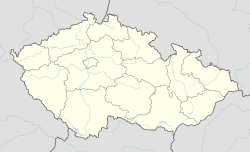Třinec
|
Třinec Trzyniec |
|||
|---|---|---|---|
| Town | |||
|
|||
| Location in the Czech Republic | |||
| Coordinates: 49°40′40″N 18°40′22″E / 49.67778°N 18.67278°ECoordinates: 49°40′40″N 18°40′22″E / 49.67778°N 18.67278°E | |||
| Country | Czech Republic | ||
| Region | Moravian-Silesian | ||
| District | Frýdek-Místek | ||
| First mentioned | 1444 | ||
| Town rights | 1931 | ||
| Town parts |
13
|
||
| Government | |||
| • Mayor | Věra Palkovská | ||
| Area | |||
| • Total | 85.38 km2 (32.97 sq mi) | ||
| Elevation | 306 m (1,004 ft) | ||
| Population (1 January 2015) | |||
| • Total | 35,884 | ||
| • Density | 420/km2 (1,100/sq mi) | ||
| Website | www |
||
Třinec (Czech pronunciation: [ˈtr̝̊ɪnɛts]; Polish: Trzyniec , German: Trzynietz) is a town in Frýdek-Místek District, Moravian-Silesian Region of the Czech Republic. It lies on the Olza River, in the historical region of Cieszyn Silesia. The town has 37,405 inhabitants as of 2009[update], in 2001 17.7% of the population were Poles. The town is notable for its steel plant, the Třinec Iron and Steel Works, largest one in the Czech Republic, which still has a major impact on the town, on its character, demographics and air pollution.
Třinec is also an important cultural center of the Polish minority in Zaolzie.
The name is of topographic origins derived reeds (Polish: trzcina, locally trzena // trzyna, strzena, trzcena).
The village of Třinec was founded in the 14th century. The village was first mentioned in 1461 when the person z [from] Trencze is attested. Politically the village belonged then to the Duchy of Teschen, a fee of the Kingdom of Bohemia, which after 1526 became part of the Habsburg Monarchy.
...
Wikipedia



